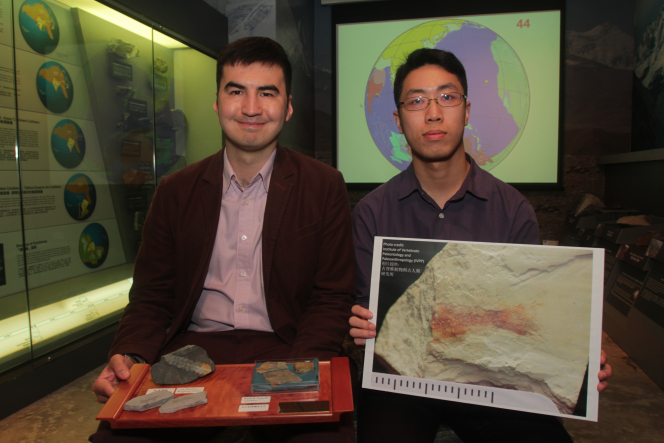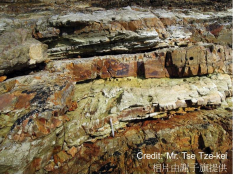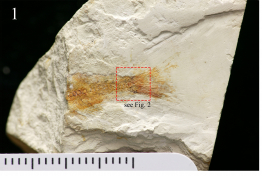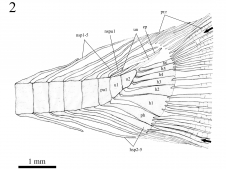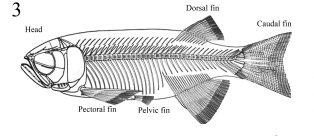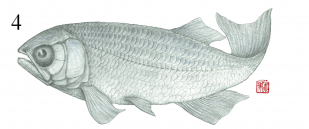Media
Hong Kong’s first identified dinosaur-era vertebrate
HKU’s Department of Earth Sciences: the fish Paralycoptera lived in Lai Chi Chong more than 140 million years ago
31 Mar 2015
Mr. Tse Tze-kei (right) and Dr. Michael Pittman (left) show the photo of a ~147 million-year-old Jurassic-aged osteoglossoid osteoglossomorph fish Paralycoptera from outcrops at Lai Chi Chong and other specimens of the dinosaur-era respectively.
A ~147 million-year-old Jurassic-aged osteoglossoid osteoglossomorph fish Paralycoptera from outcrops at Lai Chi Chong has been described. This fossil represents the first dinosaur-era fish – as well as vertebrate – from Hong Kong to be identified.
The fossil was rediscovered in the collections of the Stephen Hui Geological Museum by Mr. Edison Tse Tze-kei, graduate of the Class of 2014, Department of Earth Sciences, Faculty of Science, the University of Hong Kong (HKU). Mr. Tse studied the specimen during his HKU Faculty of Science Summer Research Fellowship and Earth Sciences Major final-year project, under the supervision of Dr. Michael Pittman who leads the University’s Vertebrate Palaeontology Laboratory and is an expert on dinosaur evolution, as well as Professor Chang Mee-mann, an Academician of the Chinese Academy of Sciences from the Institute of Vertebrate Paleontology and Paleoanthropology (IVPP) in Beijing. A paper on this study has recently been published in the open-access journal PeerJ, demonstrating international recognition of the outstanding ability of HKU undergraduate students in conducting scientific research.
The fossil consists of the posterior portion of a small, about 4cm long osteoglossoid osteoglossomorph fish from the genus Paralycoptera, and was collected at Lai Chi Chong, Tolo Channel, from rocks that have been previously radiometrically dated to 146.6 ± 0.2 million years old (Tithonian stage of the Late Jurassic). Paralycoptera is a typical member of the Mesoclupea fish fauna of Southeast China. Its discovery in Hong Kong extends the geographic range of the genus - and potentially of the Mesoclupea fish fauna - by about 700 km further south. The Jurassic-age of the Hong Kong specimen extends the temporal range of the genus about 40 million years back in time because all mainland specimens are currently known from the Early Cretaceous.
Hong Kong’s last major vertebrate fossil identification was the discovery of a ~370 million-year-old early fish (Devonian-aged placoderm fish) by Mr. Lee Cho-min 35 years ago on the north shore of Tolo Channel, Hong Kong, almost directly opposite to Lai Chi Chong.
When asked about the impact of the new specimen towards our broader knowledge of osteoglossomorph fish, Research Assistant Professor Dr. Pittman replied, ‘The fossil’s Late Jurassic age also adds support to the hypothesis that osteoglossomorph fish originated on the portion of the ancient supercontinent of Pangaea (which broke apart about 200 million years ago) that is now East Asia.’
This study improves our understanding of the habitat of Paralycoptera, based on the geological information preserved at Lai Chi Chong, a beautiful tidal rock outcrop within the Hong Kong Global Geopark of China. Elaborating on this, Mr. Tse said, ‘Our Paralycoptera specimen appears to have lived in a tropical-subtropical freshwater lake that was periodically subjected to catastrophic volcanic eruptions and earthquakes.’
Dr Pittman said that undergraduate students worldwide typically do not publish peer-reviewed research, so Edison’s valuable contribution towards Hong Kong palaeontology is a credit to him and the research ability of HKU students. The detailed identification and description of the specimen was also aided by Professor Mee-mann Chang, a global expert on Chinese fossil fish.
Commenting on the discovery, expert on Hong Kong geology Dr. Roderick J. Sewell of the Hong Kong Geological Survey, GEO, CEDD, said, ‘This discovery is very important and exciting to the development of palaeontology in Hong Kong as it suggests the possibility of finding more fossils, maybe even dinosaur fossils, in the city. It’s just a matter of time before more fossil vertebrates will be unearthed.’ It is hoped that this discovery will lead to further palaeontological research efforts in Hong Kong, and will build upon efforts to preserve and appreciate Hong Kong’s geological heritage.
For the journal article, please visit https://peerj.com/articles/865/.
For the powerpoint, please click here
Media enquiries
HKU Communications & Public Affairs Office Ms Rhea Leung (Tel: 2857 8555 / 9022 7446/ Email: rhea.leung@hku.hk ) or HKU Faculty of Science Ms Cindy Chan (Tel: 3917 5286 / 6703 0212/ Email: cindycst@hku.hk)
Figure 1: Hong Kong’s first dinosaur-era fish -
a specimen of the Chinese osteoglossoid osteoglossomorph fish Paralycoptera
(Image courtesy of IVPP).
Figure 2: Line drawing showing the
specimen’s tail anatomy.
Abbreviations: ep, epural;
h1-6, hypurals 1-6;
hsp2-5, haemal spines on preural centrum 2-5;
nsp1-5, neural spines on preural centrum 1-5;
nspu1, neural spine on u1;
ph, parhypural; pr.r, procurrent rays;
pu1, preural 1;
u1, u2, ural centra 1 and 2;
un, uroneurals;
(Image courtesy of Tse et al. 2015) .

